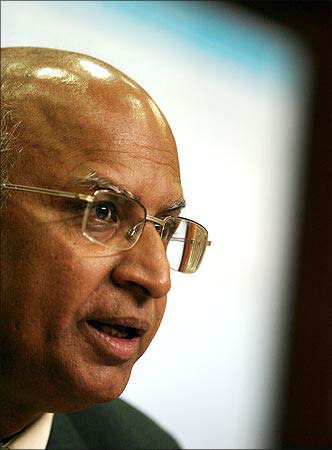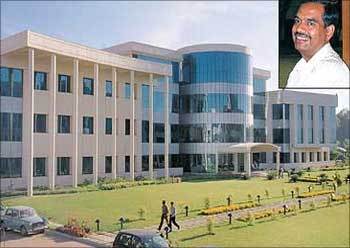
That's what the markets seem to suggest.
The BSE IT index has outperformed the BSE Sensex since the last two months, as well as in the last three weeks led by faster rise in the stock price of TCS, Wipro and Infosys, which account for over 80 per cent of the weight in the BSE IT index. So, what has changed?
Until recently, Indian IT vendor earnings were under stress as most of their addressable markets have been reeling under a downturn. The recent positive growth forecasts and claims by experts that the worst is behind us is reviving the optimism of a rebound in global economy.
The recent quarterly results of the Top three (and some mid-tier) companies was also largely ahead of the Street's estimates. And within this, while revenues from the troubled BFSI sector, which contributes a large chunk to revenues, were more or less flat on a sequential basis, these were higher as compared to June 2008 quarter.
Such developments, at a time when global IT spends are seen declining, have summed up the optimism on the road to recovery for IT stocks. However, most company managements feel that the recovery is coming but, not before 2010.
Read on to know more...

Demand clouds
During the last few quarters, challenges like declining IT budgets and discretionary spending led to a drop in business of IT vendors. The effect of this was seen in the earnings decline of most large IT companies in the recent quarters. IT purchases are projected to decline by 11 per cent during 2009 as per Andrew H Bartels, VP, Forrester Research.
S Ramadorai, CEO and MD, TCS further reiterates, "The global economy across countries continues to be weak, with job losses in various industries. We are watchful and do not rule out (negative) surprises."
IT companies have said that new business growth has been slowing down. The new client addition was slower during the June 2009 quarter for top companies, which were able to garner 26-27 new clients compared to an average addition of 38-40 clients in the same quarter, a year ago.
Recovery on the horizon?
What has driven interest in the last few months in the IT space is the possibility of a reversal of fortunes in the next few quarters on the back of an expected global recovery. Experts say that the macro-economic clouds are slowly fading as stability returns to US home sales which along with a spate of good earnings numbers from US companies (specially from financial sector) have improved sentiments.

The Infosys management however, is cautious. Says V Balakrishnan, CFO, Infosys says, "Recovery is expected to be drawn out, 60 per cent of our clients surveyed said that the recovery will be beyond first quarter of 2010. Although, some improvement is seen in verticals like financial services, but we are circumspect of whether it is going to be sustained."
Nevertheless, it is believed that IT spends lag economic recovery by at least a couple of quarters. Also, several IT companies say that recovery in US would be faster as compared to the Europe region. So, when will recovery usher in?
Bartels adds, "Looking ahead, IT buyers will start to be more active as the worries about the financial crunch and a global depression recede. By 2010, the tech recovery will spread across markets, and gather strength, with the low base level of purchases in H12009 allowing many vendors to report double-digit growth in H12010."
Some positives
The June quarter results announced by most major players were better than market expectations; mid-cap companies like Oracle Financial Services and Patni Computers also posted good numbers. While this may suggest that there are signs of recovery, companies are watchful and haven't changed their guidance significantly.
Against the revenue decline of 3-7 per cent guided in April 2009, Infosys now expects revenues to decline by a lesser margin of 3-4.5 per cent to $4.45-$4.52 billion in 2009-10.
Notably, the troubled BFSI segment that provides bulk of IT revenues (25-44 per cent) for the top companies is showing signs of improvement. In fact, greater business has started flowing from the BFSI segment and company managements are increasingly getting positive about its prospects, going ahead. Besides BFSI, healthcare and utilities are also showing growth. However challenges still persist in hi-tech and telecom sectors.
On the other hand, foray into new geographies has benefitted companies. Says Manish Dugar, CFO, Wipro, "Our early investments in emerging geographies like India and middle east have resulted in strong growth rates in these regions despite the challenging environment."

Price issues
As the first signs of recovery emerge, clouds on pricing decline may also dissipate, albeit slowly. The managements are factoring in pricing stabilisation than what they had expected a quarter ago as they have been able to convince clients for a smaller cut say analysts.
While the worst on the pricing front might be over, the outlook would depend on how long the recovery process takes. On cue, IT companies could then cut rates to boost volumes to retain clients. Nitin Padmanabhan, analyst, Centrum Broking, says, "We have build in a price decline of 5-7 per cent for 2009-10 across our large cap universe."
Padmanabhan expects a modest growth of 1.4 per cent in volumes for 2010, which could rise by 13-14 per cent in 2011 led by the expected global recovery.
War on costs
To offset the pressures, IT companies have resorted to cost cutting measures. An increase in the number of fixed price contracts is one of them, which also provide higher revenue visibility. In uncertain times, both clients as well as IT vendors prefer FPC. All top Indian companies have seen a rise in the share of FPCs in the recent quarters.
Another cost containment measure, off-shoring, is being increasingly preferred. Most big IT players (except HCL Tech) have seen a gradual increase in the share of off-shore revenues. Greater business opportunities from BPO and infrastructure management are also increasing offshore mix.
However, Viju George, analyst, Edelweiss Securities, says, "continued and inexorable offshore movement shown by TCS and Wipro is unlikely to sustain beyond 2-3 quarters."
Also, as the business cycle turns, it should increase spends towards high-end services like consulting, requiring vendors to shift larger jobs onsite. For now, along with a curb on other expenses like selling and administrative, companies have managed to hold on to margins.

Infosys:
Infosys maintained a cautious outlook on the growth recovery for the near-term as it believes that the ground realities are still challenging.
The management guided flattish rupee-based revenues for 2009-10. Operating profit margins look healthy at 34.1 per cent, however with increased hiring and investments in sales and marketing, management expects a decline of 150 basis points (bps) in OPM for 2009-10 (as against 300 bps decline guided in April 2009).
The management guided a conservative Rs 95-96 EPS; however, analysts believe that EPS for FY10 and FY11 would hover at Rs 102 and Rs 110, respectively.

TCS
June 2009 quarter volume growth for TCS at 3.6 per cent was better than peers, driven by the BFSI, pharma and utility segments. The management feels it wouldn't like to place its bets on such higher volumes for future quarters.
Analysts also perceive that TCS was more aggressive compared to its peers to increase its market share in the present slowdown.
Going ahead, a focus on the BPO business, opening GDCs outside India and increased penetration into growing emerging markets, would help TCS clock healthy volumes.
The stock trades at 17 times its estimated 2009-10 earnings.

Wipro
Wipro's volume and pricing declines in June quarter was worse compared to its peers.
However, its margin improvement in the last two quarters has been impressive and better than TCS and Infosys. This was possible due to stronger growth in the fixed price contract ratio, better offshore mix and higher employee utilisations.
Among segments, BFSI, enterprise business, telecom, BPO and media verticals are showing signs of stability and, should contribute to revenue growth in future. The stock is trading at 17 times its estimated FY10 earnings.

Tech Mahindra
A slowdown in the global telecom sector impacted revenue growth of Tech Mahindra, as it derives 90 per cent from this space---British Telecom, its biggest client was affected.
Positively, revenues from non-BT clients are growing faster, which has shrunk BT's contribution to overall revenues from 62 per cent in June 2008 quarter to 52 per cent, now.
Other concerns include the debt that came on to fund Satyam Computer's acquisition. Tech Mahindra is projected to shell out around Rs 240 crore (Rs 2.4 billion) for interest costs in 2009-10. Thus, analysts expect a 35 per cent y-o-y drop in net profits in 2009-10.
For now, most of the top IT stocks are fairly valued. While further improvements in the macro-conditions (expected from second half of 2009-10) will help drive up share prices, analysts say that any major rise in the value of rupee vis-a-vis the dollar and other currencies could spoil the party.
They prefer TCS as their top pick, followed by Infosys and Wipro.